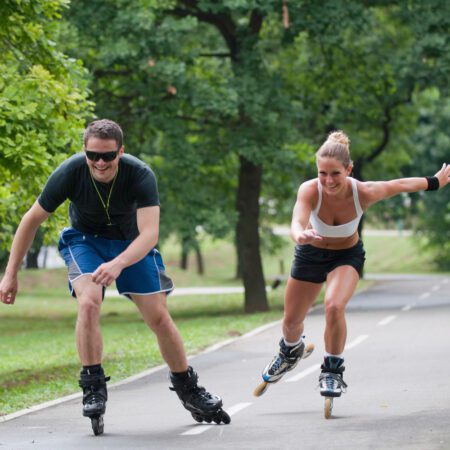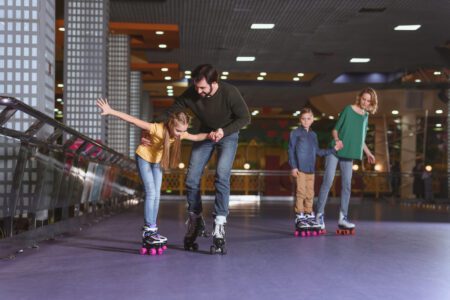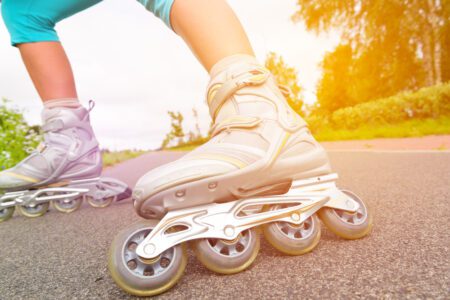 This article looks at the benefits of roller skating for exercise and the drawbacks. It includes advice for beginners, safety tips, and an overview of indoor and outdoor skates.
This article looks at the benefits of roller skating for exercise and the drawbacks. It includes advice for beginners, safety tips, and an overview of indoor and outdoor skates.
If you loved roller skating as a kid, chances are you will love it as an adult.
What you may not realize is that along with being a lot of fun, it is an excellent way to improve your cardiovascular fitness, get toned, burn calories, and more.
If you’ve never skated before, but have always wanted to, don’t hesitate to try it.
I did for years, thinking I’d look foolish or fall and injure myself.
I mentioned this to my friend Callie who said she also wished she could skate and we put our fears behind us, went to our local skating rink, and had a blast.
Did we look foolish? Probably, but we were laughing so much that we didn’t care.
Did we fall? Yes, many times each.
Were we injured? No, and we are proof that even complete newbies can safely learn to skate if they take a few common-sense precautions.
Callie and I now meet to skate for an hour or two most Sundays, and we’re getting better every week. We enjoy it so much that we bought our own skates and protective gear, so we don’t have to hire them.
We both went with FoxySkate Women’s Roller Skates. They come in five colors – I got the Classic Teal and Callie the Holographic colorway. They are comfortable and supportive, fit perfectly, and can be used for indoor or outdoor skating.
We opted for JBM Rider Protective Gear, which comprises a helmet, knee and elbow pads, and wrist guards. All are comfortable to wear, and the pads and wrist guards are breathable and washable.
Table of Contents
Whom does it suit?
While most people can learn to skate, I don’t recommend it for beginner-level seniors or pregnant women.
How much exercise should we be getting?
CDC statistics show that over 60% of adult Americans do not meet the recommended standards of physical activity, and approximately 25% of Americans do not participate in any physical activity at all.
A lack of exercise contributes to serious health problems, including diabetes and cardiovascular disease.
If you’ve always been sedentary, even thinking about getting into shape can be daunting, but don’t give up on yourself.
The good news is that you can significantly improve your health and fitness without spending an hour a day at the gym or running marathons.
Exercising for 30 minutes five times a week has significant health and fitness benefits.
If you don’t have 30 minutes to spare, increasing the intensity from moderate to brisk for 20 minutes 3 times a week can be equally beneficial. And you don’t even have to be athletic.
Any physical activity that elevates your heart rate and increases your breathing rate can benefit you. It doesn’t have to be an activity classed as exercise.
If roller skating for exercise isn’t for you, try swimming, dancing, trampolining, or jumping rope.
The Benefits of Roller Skating
Low-impact –
Roller skating is low-impact, making it gentle on the joints and easy on the knees. 
Burns calories –
Roller skating gets your heart rate up, which helps you burn more calories.
Regular sessions promote weight loss by burning up to 9 or 10 calories a minute when skating briskly.
Skating leisurely, you will burn approximately 4 calories a minute.
These numbers are average.
The number of calories you burn while roller skating for exercise will depend on your effort and weight, with heavier people burning more calories than slimmer people.
The type of skates you use also affects the calories burned.
A 150 lb individual will burn approximately 482 calories an hour wearing quad skates and 600 calories wearing inline skates.
Tones the entire lower body –
Roller skating is an excellent lower body workout, toning the glutes, quads, hamstrings, and calves.
If you’re consistent with your sessions, you will quickly see improved calf muscle definition and tighter, toned hamstrings and quads.
Our glutes comprise the gluteus maximus, gluteus medius, and gluteus minimus.
The twisting, turning, and bending movements involved when skating target all three, toning, firming, and lifting the buttocks.
In fact, skating is among the best exercises you can do for your butt.
It also targets the core, including the abs, obliques, and back.
Pumping your arms back and forth as you skate will work your arms and shoulders.
Makes you stronger –
Another of the benefits of roller skating for exercise is that when done regularly, it will improve your lower-body strength, including your muscles and bones.
Strong muscles can help to prevent falls, while strong bones can help ward off osteoporosis.
This improved strength can keep you more active as you age.
Improves balance and coordination –
Roller skating engages the lower back and abdominal muscles, necessitating that you hold your core steady to stay upright.
It requires you to coordinate your arms and legs while keeping your balance and moving forward.
Over time, these movements will enable you to balance more efficiently and be better coordinated.
Seniors, in particular, will appreciate this as it can lower the risk of falls.
Improves stamina and endurance –
Roller skating increases your heart rate, improving your stamina and endurance.
As you roller skate more, you will find that you can skate for extended periods without getting tired.
In fact, roller skating is often used as a form of cross-training by runners and other athletes looking to improve their endurance.
Enhances the mind-body connection –
As your skating skills improve, changing your moves will enhance your mind-body connection.
When you roller skate, your body, and mind must work together to keep you balanced and moving forwards. This requires coordination and concentration.
As you roller skate more, you will find that your mind and body become better at working together.
Improves heart health –
Heart disease kills over three-quarters of a million people in the USA, and this figure is rising.
Cardiovascular workouts such as roller skating increase the heart rate, strengthening the heart and lowering the risk of aheart attack when undertaken regularly.
It also reduces the risk of stroke and diabetes.
Skating at a moderate pace can increase your heart rate to between 140 and 160 beats a minute.
Speed skating can accelerate your heart rate to 180 beats per minute.
Lowers the risk for diabetes –
Along with following a healthy diet, regular aerobic exercise and strength training are our best defenses against diabetes.
Modifying your diet is up to you, but roller skating has you covered for the other two.
As well as strengthening your heart, regular sessions will lower your blood glucose and cholesterol levels, helping you manage and maybe even avoid diabetes.
Thirty minutes of light to moderate-intensity aerobic activity 5 times a week is recommended.
Boosts mood and lowers stress –
Roller skating for exercise, sport, or fun releases endorphins. These “feel-good hormones” produce a euphoria similar to that of a runner’s high.
Endorphins also boost mood and reduce stress so you can focus on the present moment and forget your worries.
The Drawbacks of Rolling Skating
There’s a learning curve –
With roller skating, there is a learning curve. You can’t just put the skates on and glide with grace.
Initially, prepare to spend more time on the floor or clinging to a friend for support than upright.
If you enjoy it, stick with it. It may take weeks or even months, but you will get better at it.
It comes with risks –
Roller skating comes with more risks than many other physical activities.
Along with fall-induced injuries, collisions can occur with stationary objects or people.
The more adept you become, the less likely you will be to fall or skate into something or someone.
Wearing protective gear will significantly reduce the risk of injury if a mishap occurs.
How to Roller Skate
Tips for new skaters
Now that you know the benefits of roller skating for exercise, if you’d like to give it a try, below you will find some tips to help you get started:
Before you lace up your skates, mentally prepare yourself to fall. Everyone does.
Wear protective gear, including a helmet, knee, and elbow pads, to help prevent injuries.
Wear comfortable clothing that won’t impede your movement.
With your feet approximately shoulder-width apart, bend your knees to a 90-degree position and lean forward slightly, keeping your weight on the balls of your feet.
This stance will make it easier to balance.
Moving your feet slightly can make it easier to remain upright while standing still.
While still in a semi-Squat, try walking with your heels close to each other and your toes pointed out.
Take it slow, first going forward, then right, then left, repeating these.
You will also need to learn how to stop. Stopping involves pressing the skate’s toe stop into the ground. The harder you press, the faster you will stop.
The position of the brake differs depending on the type of skates.
When you’re ready to venture outside, start by skating around your house or in your driveway.
Take small, slow steps. This will help you get used to the feel of the skates.
Practice the above moves until your balance and confidence improve.
After a while, you will be ready to take longer and quicker strides.
To do this, push forward with one foot, glide, then swap your leading foot. Continue this movement, alternating feet.
Once you master going forward, make some turns, leaning your body slightly to the right to go right and to the left to go left.
If desired, you can also learn to skate backward with more experience.
When you’re comfortable skating around your house, try skating in a rink, park, or on a paved trail.
If skating outdoors, do so in a well-lit area with plenty of open space so you can see where you’re going.
Roller Skating Safety Tips
While every type of exercise has risks, skating carries more risk due to its speed. 
Rolling skating injuries are usually caused by falling. Cuts and scrapes are common, but wrist sprains and fractures are also possible.
Wearing wrist guards will protect your wrists, elbow pads your elbows, and knee pads your knees.
It’s also possible to sustain a head injury from a fall, including a concussion. Because of this, it is vital that beginners protect themselves by wearing a helmet.
Choose well-fitting skates that are the correct type for your terrain.
Always be aware of your surroundings, particularly if skating outdoors.
Don’t skate near traffic or in crowds.
Don’t roller skate if you are pregnant. When pregnant, your center of gravity shifts, making the possibility of falling while skating higher.
Benefits of Roller Skating Summary
I’m sure you’ll agree that the benefits of roller skating for exercise make it well worth trying.
It’s low-impact, assists with weight loss, and tones the lower body. Done regularly, it improves balance, coordination, stamina, and endurance.
It enhances the mind-body connection, can improve health, boosts mood, and lower stress. And, it’s a lot of fun!
Skating is a challenge at first, but it will become easier with practice.
So, if you are looking for a new way to get in shape, roller skating may be the perfect activity.

